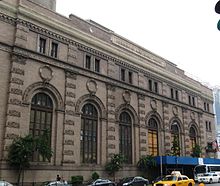- New York City steam system
-
The New York City steam system is a district heating system which takes steam produced by steam generating stations and carries it under the streets of Manhattan to heat, cool, or supply power to high rise buildings and businesses. Some New York businesses and facilities also use the steam for cleaning, climate control and disinfection.
The New York Steam Company began providing service in lower Manhattan in 1882. Today, Consolidated Edison operates the largest commercial steam system in the United States. The organization within Con Edison that is responsible for the system's operation is known as Steam Operations, providing steam service to nearly 1,800 customers and serving more than 100,000 commercial and residential establishments in Manhattan from Battery Park to 96th Street uptown on the West side and 89th Street on the East side of Manhattan. Roughly 30 billion lbs. (just under 13.64 megatons) of steam flow through the system every year.
Contents
Effects on the environment
Cogeneration and Heat Recovery Steam Generation (HRSG) significantly increase the efficiency of fuel usage and thereby reduces the emission of pollutants, such as NOx, SO2, CO2, and particulate matter, and reduce the city's carbon footprint. Approximately 30% of the ConEd steam system’s installed capacity and 50% of the annual steam generated comes from cogeneration.[1] Con Edison is promoting the use of steam for cooling in the summer months, something that can be accomplished with the installation of absorption chillers.[2] Such trigeneration systems result in additional energy and pollution savings, while reducing peak electrical loads.
Clouds of condensation can sometimes be seen rising from manholes in Manhattan, although this is usually caused by external water being boiled by contact with the steam pipes, rather than leaks in the steam system itself.
At least 12 steam pipe explosions have occurred in New York City since 1987.[3]
Plants
- 74th Street Station (at FDR Drive) 40°46′04″N 73°57′04″W / 40.767727°N 73.951059°W
- Ravenswood Station (Vernon Blvd., Queens) 40°45′33″N 73°56′43″W / 40.759192°N 73.945295°W
- 60th Street Station (at York Ave.) 40°45′31″N 73°57′33″W / 40.758705°N 73.959109°W
- 59th Street Station (at 11th Ave.) 40°46′18″N 73°59′28″W / 40.771605°N 73.991097°W
- East River Station (14th St. and FDR) (cogeneration) 40°43′41″N 73°58′25″W / 40.727932°N 73.973729°W
- Hudson Avenue Station (at John St. Brooklyn) 40°42′16″N 73°58′49″W / 40.704306°N 73.980212°W
- BNYCP Plant (Brooklyn Navy Yard Cogeneration Partners) (cogeneration) 40°41′58″N 73°58′34″W / 40.699314°N 73.976086°W
See also
Other steam companies:
- American District Steam Company
- Boston Heating Company
- Compagnie Parisienne de Chauffage Urbain
References
- ^ "Con Edison Steam Long Range Plan 2010-2030", p. 69
- ^ Benefits and Case Studies of Hybrid Cooling Using Steam, Consolidated Edison
- ^ Asbestos and Aging Pipes Remain Buried Hazards, The New York Times
External links
Categories:- Residential heating
- New York City infrastructure
Wikimedia Foundation. 2010.



